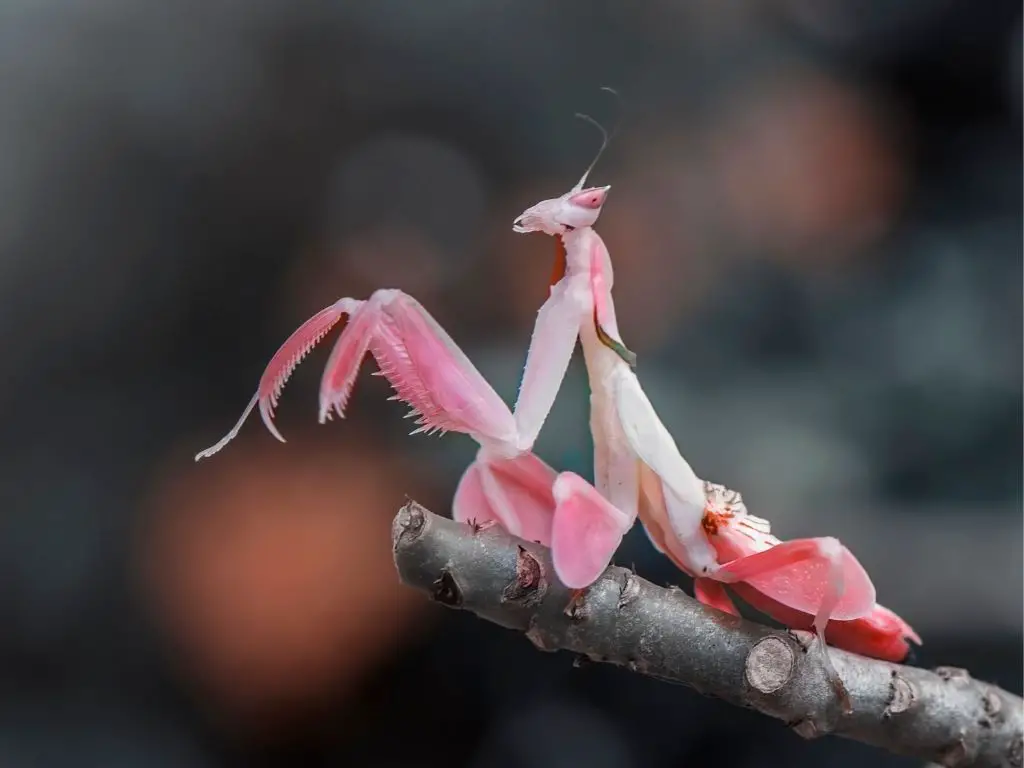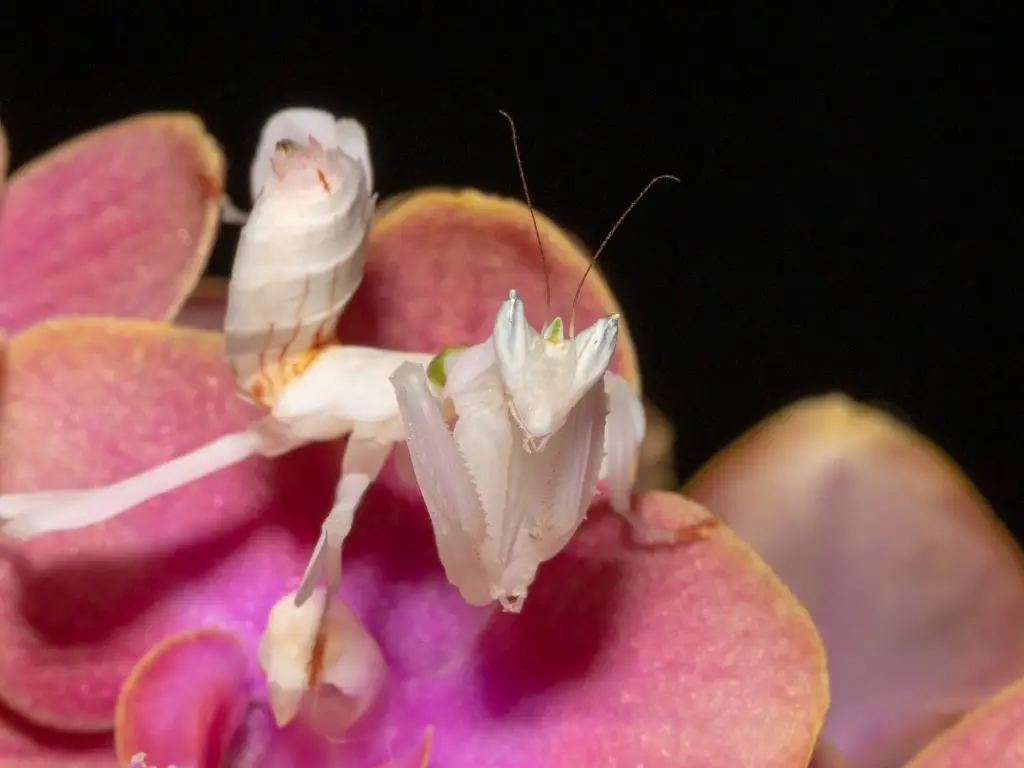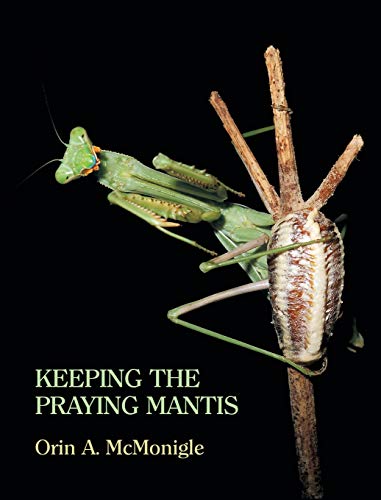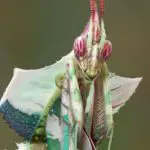Hymenopus coronatus, also known as the orchid mantis, is a beautiful and most sought after pet mantis. It is not the easiest species to keep though. In this care guide, I’ll tell you how to keep orchid mantis as pets.
To keep orchid mantis, place it in a suitable escape-proof and ventilated container. Add moist substrates as bedding, and mist regularly. Keep the mantis between 23-28 °C, under 60-70% humidity. Feed the orchid mantis with only flying insects, and do not overfeed.
That sounds simple right? Let’s drill in a little further to understand more about orchid mantis and other things that you need to know.
- Introduction to Orchid Mantis
- Why is Orchid Mantis Hard to Keep?
- Things to Consider when Buying an Orchid Mantis
- How to Sex Orchid Mantis?
- Enclosure for Orchid Mantis
- How to Feed Orchid Mantis
- Quenching the Thirst
- Lighting, Temperature and Humidity
- Recommended Supplies and Resources
- Molting Care for Orchid Mantis
- How to Deal with a Sick Orchid Mantis
- How to Breed Orchid Mantis
Introduction to Orchid Mantis

Orchid mantis is found mainly in the tropical rainforests of Southeast Asia. They look like flowers, earning them the name orchid mantis.
Thanks to their flower-like morphology, orchid mantises effortlessly attract and capture pollinating insects. It seems like they are even more attractive than real flowers. It is also possible that orchid mantises are spared from their predators through this mimicry.
Orchid mantis undergoes incomplete metamorphosis, where the nymphs undergo 6-9 molts in 2-5 months to become adults. The adult orchid mantises have a body length between 5-8 cm, where the females are always larger than the males.
The nymphs of orchid mantis look very different from the adults. Newly hatched nymphs are black and red in color. This dangerous-looking coloration helps them to fend off their enemies.
As it molts, it may start to turn white, pink, yellow etc., depending on the environmental factors such as humidity, temperature and lighting. Don’t get too worried if it doesn’t look like the beautiful flower-like mantis you saw in the photos. It will, once it turns into an adult.
Why is Orchid Mantis Hard to Keep?
Orchid mantis is generally considered hard to keep because of high mortality among the nymphs. They are picky on food, and can easily fall sick. Molting is difficult due to the enlarged lobes on the legs of the mantis. Moreover, orchid mantis requires high humidity, which can be difficult to maintain.
Things to Consider when Buying an Orchid Mantis
Orchid mantises are not cheap. You want to make sure it is worth your money. Here’re the things to consider when buying an orchid mantis.
- Decide whether you want a male or female.
Males are smaller, short-lived, and cheaper. Meanwhile, females are the total opposite. Choose one that you prefer, or choose both!
- Age or developmental stage.
You can buy orchid mantis as an adult, young or old nymph, or egg case. Generally, the younger it is, the bigger the uncertainty to reach adulthood, and the cheaper it is. In contrast, older mantises are more expensive, but you don’t get to experience the fun from keeping them as young nymphs. Try not to buy an adult mantis, since there’s no way for you to ascertain their age. They could be at the end of their life.
- Choose one that looks healthy.
Orchid mantis can die easily. So, choose one that is healthy to begin with.
- Buy 2 or more mantises.
The survivorship of orchid mantis is not high, unlike those commonly kept mantis species for beginners. If you have the budget, consider getting 2 or more of them, especially if you are buying young nymphs.
How to Sex Orchid Mantis?

If you buy an old-enough orchid mantis from a store, you can ask for a male or female mantis. But, how do you make sure you get the right one?
The female orchid mantis has a green line on her back and a horn between her eyes. In contrast, male orchid mantis has a brown line on its back, and lacks a horn. Female has 6 abdominal segments, and male has 8. Lastly, the female is much bigger than the male of the same age.
Bear in mind that the aforementioned characteristics are visible only after the 4th instar (it takes 3 molts to reach the 4th instar). They become more apparent with each molt.
Enclosure for Orchid Mantis
Make sure the height of the container is 3 times the length of your mantis to facilitate molting. The length and width of the container can be around 2-3 times the length of your mantis so that it has some space to move around.
Do not put your mantis in a container too big for it to find its prey. Younger nymphs (first/second instar) can be housed temporarily in a small deli container and moved to a bigger container as they grow.
Bedding in the enclosure is crucial for orchid mantis to maintain sufficient moisture. Lay some coir, peat mosses or potting soil into the enclosure. Add some water to make it moist, but not excessively wet. Evaporation will provide enough moisture to your orchid mantis. Add more water as it dries up.
A cleaner and cheaper setup is by using paper towel instead of substrates. Simply replace the paper towel once it gets dirty.
Decorate the enclosure with twigs, barks, or plants. Orchid mantis prefers to stay on the twigs than on the floor.
Make sure the enclosure has a lot of vents for ventilation. Otherwise, you will face issues with molds.
Whenever possible, choose a housing with mesh cover, not only for the sake of ventilation but also to allow the mantises to molt by hanging themselves on the mesh. There is more vertical space for molting by hanging on the mesh cover than hanging on a twig in the enclosure.
Clean the enclosure at least fortnightly. Dispose the bedding substrate, and wash the enclosure with plain water. Lay a new layer of bedding and replace the decor if necessary.
Can Orchid Mantises be Housed Together?
Orchid mantises can be housed together when they are in first and second instars. Make sure there is sufficient food to avoid cannibalism. Those who reach 3rd instar should be separated immediately, as their size is significantly larger (especially female), and can easily slaughter the smaller nymphs.
How to Feed Orchid Mantis
Feed the orchid mantis nymph daily with fruit flies. As it grows larger, use house flies or blow flies. Avoid using crickets. Mealworms can be used as a backup, but manual feeding is required. The prey should be half the size of the mantis, or smaller. Do not overfeed orchid mantis to avoid health issues.
In nature, orchid mantis pretend to be a flower, and wait for their prey. They prefer flying insects rather than crawling insects, which are not attracted to flowers as much as flying ones.
Flightless fruit fly is an excellent choice for the younger nymphs. As your mantis turns larger, you can swap over to house flies and blow flies. They are convenient to use. You can leave the fly pupae on a dry plate in the mantis enclosure if you need to be away for a few days.
You can refer to my guide on choices of feeder insects and how to cultivate them for your mantis.
The feeding regime for younger nymphs (eg. 1st to 3rd instars) can be daily. This is to help them get through the most susceptible period fast enough. 4th instar onward can be fed every other day. Having said that, it depends on the portion of food that you are giving. As a general rule of thumb, if the stomach of the mantis is flat, you need to feed it. Excessive feeding can cause indigestion, making your mantis fall sick.
Orchid mantis has a sensitive stomach. It doesn’t seem to do well with crickets. Many owners reported their orchid mantis fell ill from eating crickets. It can be due to indigestion, or caused by the cricket feces.
In the event where you run out of flies, mealworms can be used. Decapitate the mealworm and hold it directly in front of your orchid mantis to feed it. Remember, mealworms should be used only as a temporary backup! They have high fat content, which is not healthy for your mantis.
Remember, you should always give small prey to your mantis, especially if they are young nymphs. That will increase the success rate of hunting. When the mantis reaches adulthood, the prey can be as big as the mantis.
Sometimes, your mantis may refuse to eat. Check out the reasons and how to deal with it in this article.
How to Deal with Leftover Food
Most of the time, the mantis will devour the whole prey. Sometimes, there’ll be leftovers, say broken legs or wings.
Any leftover carcasses should be removed as soon as possible to prevent molds, ants and other pests. If the mantis shows no interest in the prey, remove the prey after a day, and try again the next day. If the mantis shows signs of molting, remove the prey immediately.
Although not required, you can hold the feeder insect using a tweezer or needle, and offer it to the mantis. The feeder insect can be offered alive or dead (freshly killed). You can also offer a portion of the feeder insect (eg. leg only) if your mantis is too small. This method is especially useful for injured/weaker mantis, or for those individual mantis which are not good at hunting.
Quenching the Thirst
Mantises obtain enough water from their prey. Sometimes, they take a sip on the water droplet. Misting from time to time will ensure they have enough water. You can also wet a chopstick and put it in front of your mantis to drink. A water dish is not required.
Lighting, Temperature and Humidity
In general, orchid mantises do not require additional lighting. Natural daylight is sufficient. Don’t put them in the dark, because they rely on their eyesights to hunt.
Of course, you can add an LED light source so that you can easily see your mantis. I use a timer to light the enclosure for 8 hours a day to mimic the natural photoperiod.
Keep your orchid mantis at around 23-28 °C during the day. The higher the temperature, the faster the mantis grows.
It is extremely important to keep the enclosure humid. Orchid mantis requires 60-70% humidity. They may die if the humidity is too low or too high.
Mist twice a day into the enclosure. Add some water into the substrates to keep it moist, but not overly wet. This should provide consistent humidity to your orchid mantis. You can use a hygrometer to monitor the humidity, although it’s not a must.
Don’t mist directly onto the mantis. They don’t like it. The mist may drown small nymphs. You should spray on the enclosure wall instead.
Recommended Supplies and Resources
Here’re my recommended supplies and resources that you can consider getting for your orchid mantis. I’ll earn a small commission from eligible purchases you make after clicking those links. It helps me maintain this site without additional cost to you.

Keeping the Praying Mantis
This is great book by Orin McMonigle on mantis keeping. Written in an easy to understand and concise manner, this is the ultimate guide that any serious mantis-keepers need to read!
- Enclosure
- Lighting
- Thermometer/Hygrometer
- Heat mat
- Tweezers
- Fly pupa
- Fruit flies
- Small crickets
- Dubai cockroach
- Mealworms
Molting Care for Orchid Mantis
When orchid mantis is about to molt, it becomes inactive and looks fatter than usual. It will also stop feeding.
Molting is a dangerous process, especially for orchid mantis, where it may die trying. As the owner, you should do your best to help your mantis molts.
Make sure there are places for the mantis to hang itself upside down, either on the mesh enclosure cover or twigs. The space below the hanging point should be at least twice the length of your mantis. Keep the mantis hydrated by misting the enclosure, and remove all other living animals in the enclosure.
How to Deal with a Sick Orchid Mantis
Orchid mantis can get sick from over-eating and consuming filthy food. Symptoms include loss of appetite and vomiting of dark fluid.
You can only wait for your orchid mantis to recover. Make sure it stays hydrated. Some hobbyists feed diluted honey to help sick mantis recover. Simply dip a chopstick in diluted honey, and offer it to the mantis. The honey provides energy and nutrients for the mantis to get through this period.
How to Breed Orchid Mantis
Breeding orchid mantis is difficult, making them expensive in the trade. If you are keen to try out, here are some tips.
But first, why is it difficult to breed orchid mantis?
It is difficult to time the mating because male and female mantises grow at different speeds. Moreover, the male orchid mantis is too small, and can be easily eaten by the female. Even if pairing is successful, the mother mantis is susceptible to difficult labor. And lastly, orchid mantis eggs have a low hatch rate.
Because the male orchid mantis grows too fast, you need to have a few batches of male mantises to breed them. Otherwise, your male mantis becomes too old to mate by the time you have your female mantis ready.
You can slow down the growth rate of your male mantis by keeping it under a cooler condition, but not below 20 °C in the day. Conversely, you can accelerate the growth of your female orchid mantis by keeping it at a warmer temperature.
The breeding advice for orchid mantis is generally the same as what I’ve outlined in the mantis breeding guide, which you should refer to.


